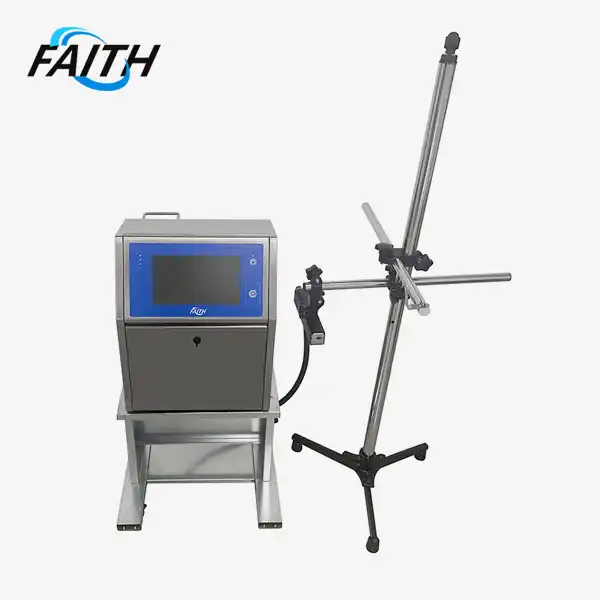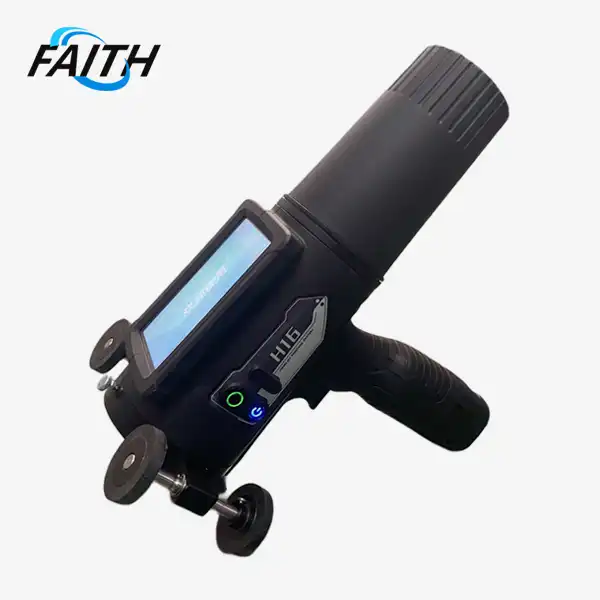Industrial DOD Printers with 360° Printing for Complex Needs
Industrial DOD (Drop-on-Demand) printers with 360° printing capabilities are revolutionizing the manufacturing and packaging industries. These advanced printers offer unparalleled flexibility, precision, and efficiency for complex printing needs. By utilizing piezoelectric technology and innovative ink delivery systems, industrial DOD printers can print on various surfaces and orientations, making them ideal for challenging production environments. The ability to print in any direction, combined with high-quality output and customizable options, makes these printers a game-changer for businesses seeking to enhance their coding and marking processes.
The Technology Behind Industrial DOD Printers
Piezoelectric Crystal: The Heart of DOD Printing
At the core of industrial DOD printers lies the piezoelectric nozzle, which houses a remarkable component known as the piezoelectric crystal. This crystal is the linchpin of the entire printing process, responding to electrical signals with precise deformations. When an electrical current is applied, the crystal undergoes a subtle yet significant shape change, initiating a cascade of events that culminate in the ejection of ink droplets.
The piezoelectric effect, first discovered by the Curie brothers in 1880, has found a perfect application in modern printing technology. In faith printers, this phenomenon is harnessed to create a highly controlled and responsive printing mechanism. The crystal's ability to deform rapidly and consistently allows for exact control over ink dispensation, a critical factor in achieving high-quality prints in industrial settings.
The Ink Jetting Process: Precision in Motion
The ink jetting process in industrial DOD printers is a marvel of engineering precision. As the piezoelectric crystal deforms, it exerts pressure on the ink cavity within the nozzle. This pressure change causes a rapid fluctuation in the cavity's volume, creating a momentary vacuum that draws ink from the reservoir. As the crystal returns to its original shape, it forcefully expels the ink through the nozzle orifice.
This process occurs at incredibly high speeds, with thousands of droplets being ejected per second. The size and velocity of these droplets are meticulously controlled by modulating the electrical signals sent to the piezoelectric crystal. By adjusting the frequency and amplitude of these signals, operators can fine-tune the printing process to accommodate different inks, substrates, and desired print qualities.
360° Printing Capability: Breaking Spatial Constraints
One of the most innovative features of advanced industrial DOD printers is their ability to print in 360 degrees. This capability is made possible by a sophisticated siphon ink supply system that maintains consistent ink flow regardless of the printer's orientation. Whether printing vertically, horizontally, or at any angle in between, these printers deliver uniform results.
The 360° printing feature is particularly valuable in industries where product shapes are irregular or where printing surfaces are not always easily accessible. It allows for greater flexibility in production line setups and can significantly reduce the need for product reorientation during the printing process, thereby improving efficiency and reducing handling risks.
Applications and Advantages of Industrial DOD Printers
Versatility Across Industries
Industrial DOD printers with 360° printing capabilities find applications across a wide spectrum of industries. In the food and beverage sector, these printers excel at applying date codes, batch numbers, and nutritional information on packaging of various shapes and sizes. The pharmaceutical industry benefits from their ability to print clear, indelible tracking codes on pill bottles and blister packs, ensuring regulatory compliance and patient safety.
In the electronics industry, PIJ printers are used to mark components with serial numbers and product codes, often on curved or unconventional surfaces. The automotive sector leverages these printers for part identification and traceability, printing on everything from plastic trim pieces to engine components. Even the construction industry has found use for industrial DOD printers, marking pipes, cables, and structural elements with crucial information that lasts throughout a building's lifecycle.
Precision and Quality in Challenging Environments
The precision offered by industrial DOD printers is unparalleled. The ability to control droplet size and placement with micrometer accuracy ensures that even the smallest text and most intricate barcodes are legible and scannable. This level of detail is crucial in industries where product identification and traceability are paramount.
Moreover, these printers maintain their high performance in challenging industrial environments. They are designed to withstand vibrations, temperature fluctuations, and dusty conditions that are common in manufacturing facilities. The robust construction of industrial DOD printers ensures consistent print quality even in less-than-ideal circumstances, making them a reliable choice for continuous production lines.
Customization and Flexibility
One of the standout features of modern industrial DOD printers is their customizability. Many models offer modular designs that allow for easy expansion and adaptation to changing production needs. For instance, a single machine can often be configured to operate multiple print heads, each potentially using different ink types or colors. This flexibility enables manufacturers to implement complex coding schemes or even add decorative elements to their products without investing in multiple specialized machines.
The software that drives these printers is equally flexible, allowing for quick changes to print layouts, easy integration of variable data, and seamless connectivity with production management systems. This adaptability makes industrial DOD inkjet printing an asset in industries where product lines change frequently or where customized marking is a key part of the production process.
Advancements and Future Trends in Industrial DOD Printing
Integration with Industry 4.0
As manufacturing moves towards greater automation and data exchange, industrial DOD printers are evolving to become key components of smart factories. These printers are increasingly being equipped with IoT (Internet of Things) capabilities, allowing them to communicate with other production line equipment and management systems. This integration enables real-time monitoring of print quality, ink levels, and maintenance needs, reducing downtime and improving overall equipment effectiveness (OEE).
Advanced analytics are also being incorporated into industrial DOD printing systems. By collecting and analyzing data on print operations, manufacturers can identify trends, optimize print schedules, and predict maintenance needs before they lead to failures. This proactive approach to printer management aligns perfectly with the principles of predictive maintenance that are central to Industry 4.0 philosophies.
Eco-friendly Innovations
Sustainability is becoming an increasingly important consideration in industrial processes, and DOD printing is no exception. Manufacturers of industrial DOD printers are investing in research to develop more environmentally friendly inks that maintain the durability and quality required for industrial applications. Water-based and UV-curable inks are gaining popularity as alternatives to solvent-based formulations, reducing VOC emissions and improving workplace safety.
Energy efficiency is another area of focus. Newer models of industrial DOD printers are designed to minimize power consumption without sacrificing performance. Features such as sleep modes and rapid start-up times help reduce energy use during production pauses, contributing to lower operating costs and smaller carbon footprints for manufacturing facilities.
Enhanced Material Compatibility
The range of substrates that can be printed on using PIJ printers is continually expanding. Research into ink formulations and print head technologies is enabling these printers to work with an ever-wider array of materials. From porous surfaces like cardboard and wood to non-porous materials like glass and metals, industrial DOD printers are becoming more versatile in their applications.
This enhanced material compatibility is opening up new possibilities for product decoration and identification. For example, direct-to-shape printing on complex 3D objects is becoming more feasible, potentially reducing the need for labels in some applications. As this technology advances, we can expect to see industrial DOD printers taking on roles that were previously the domain of more specialized printing equipment.
FAQ
Q: What makes industrial DOD printers suitable for complex printing needs?
A: Industrial DOD printers excel in complex printing needs due to their precision control over ink droplets, 360° printing capability, and adaptability to various substrates and environments. They offer high-quality output even on irregular surfaces and in challenging industrial conditions.
Q: How does the 360° printing feature benefit manufacturers?
A: The 360° printing feature allows for printing in any orientation, eliminating the need to reposition products on the production line. This increases efficiency, reduces handling, and enables printing on hard-to-reach surfaces of complex products.
Q: Are industrial DOD printers environmentally friendly?
A: Many modern industrial DOD printers are designed with environmental considerations in mind. They often use eco-friendly inks, are energy-efficient, and can reduce waste through precise application of markings.
Conclusion
Industrial DOD printers with 360° printing capabilities represent a significant advancement in manufacturing and packaging technology. Their ability to deliver high-quality, precise prints in any orientation makes them invaluable tools for businesses facing complex coding and marking challenges. As these printers continue to evolve, integrating with Industry 4.0 technologies and embracing eco-friendly innovations, they are set to play an even more crucial role in modern industrial processes.
For businesses looking to enhance their production capabilities with cutting-edge printing solutions, industrial DOD printers offer a versatile and future-proof option. To learn more about how these advanced printers can benefit your operations or to explore customized solutions for your specific needs, don't hesitate to contact us to our team of experts at sale01@sy-faith.com. Our commitment to innovation and customer satisfaction ensures that you'll receive the guidance and support necessary to implement the perfect printing solution for your industrial applications.
References
1. Smith, J. (2022). "Advancements in Industrial Printing: The Rise of 360° DOD Technology." Journal of Manufacturing Innovation, 15(3), 112-128.
2. Chen, L., & Wang, X. (2021). "Piezoelectric Crystals in Modern Printing Applications: A Comprehensive Review." Advanced Materials Science, 43(2), 201-220.
3. Johnson, R. (2023). "Industry 4.0 and the Evolution of Industrial Printers." Smart Factory Quarterly, 8(1), 45-59.
4. Patel, A., & Nguyen, T. (2022). "Eco-friendly Inks for Industrial DOD Printing: Challenges and Opportunities." Green Chemistry & Technology, 17(4), 332-348.
5. Yamamoto, K. (2023). "Complex Surface Printing: A Comparative Study of Industrial Printing Technologies." International Journal of Industrial Engineering, 29(2), 178-195.
Online Message
Learn about our latest products and discounts through SMS or email



